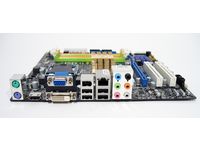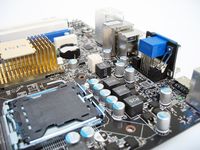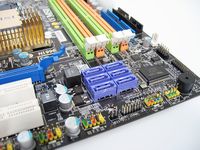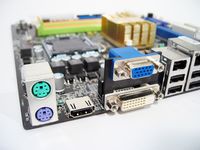Move Over G45: Nvidia's GeForce 9300 Arrives
MSI’s P7NGM-Digital Motherboard

Nvidia is actually launching two motherboard-based GPUs: the GeForce 9300 and GeForce 9400. Both chipsets are the same, except the 9400 sports a 580 MHz core and 1,400 MHz shaders to the 9300’s 450 MHz core and 1,200 MHz shaders. The test mule we received was MSI’s P7NGM-Digital, based on the slower GeForce 9300.
MSI’s P7NGM-Digital
The MSI board is likely a good representation of what you’ll be able to get for roughly $100 when GeForce 9300 platforms start shipping. It fits in a micro-ATX form factor and delivers moderate connectivity. Naturally, there’s only one chipset component, which MSI covers with a passive aluminum heatsink. Small, quiet, and well-equipped—the P7NGM-Digital has the makings of a respectable platform.


An LGA775 socket interface accommodates everything from lowly Celerons to Core 2 Extremes (at FSBs as high as 1,333 MHz and despite the four-phase power circuitry). Four DDR2 DIMM slots take a maximum of 8GB running at 800 MHz.
Available I/O includes a Realtek 8111C Gigabit Ethernet controller, a JMicron FireWire 400 chip, a JMicron parallel ATA controller, one PCI Express x16 slot, one PCIe x1 slot (both v. 2.0), and two standard PCI slots. The 9300 chipset drives six SATA 3 Gb/s ports and Nvidia’s RAID software gives you access to RAID 0, 1, 0+1, 5, and JBOD modes.


Though overall a well-rounded configuration, our biggest problem with the P7NGM-Digital is its back-panel I/O. MSI enables PS/2 mouse and keyboard ports, HDMI output, a VGA connector, four USB 2.0 ports, a FireWire 400 connector, Gigabit Ethernet, and six 1/8” audio mini-jacks. There’s also a DVI output, but it’s of the single-link variety, so when we connected our 30” Dell display, it wouldn’t do anything larger than 1280x800. The panel is missing optical audio output, too. Fortunately, the chipset supports 7.1 LPCM audio over HDMI.
Our recommendation: find a board with dual-link DVI, at least. Although Dell’s 3008WFP includes its own chipset that doesn’t require dual-link, the 3007 is a far better value right now, and it does require dual-link connectivity.
Get Tom's Hardware's best news and in-depth reviews, straight to your inbox.
Current page: MSI’s P7NGM-Digital Motherboard
Prev Page Out Of The Chipset Business? Not Yet, At Least Next Page Test System And Benchmark Configuration-
Ryun Good article but I feel compelled to say that I don't understand your choice for pitting the 790GX (~$140 board) and a 5400+ (~$80) with an the E7200 (~$120) and the G45 (~$100).Reply
Wouldn't it have made more sense to pair up similarly priced components, such as the 780g and 5400+ vs a E2180 and G45? Maybe someone could explain the reasoning? -
ricstorms I think a better Intel processor for an apt comparison should have been the E5200, which is only about $10 more expensive than the 5400+. Also, no mention was made that the 790GX platform is much more versatile, thanks to its 2 PCIExpress x16 slots (albeit running in x8 mode in Crossfire). Also, I would have liked to see the overclocking results with all three platforms, that is one of the strengths of the 790GX platform. (since AMD processors have fallen from grace, its almost impossible to find good reviews, I didn't see one in a google search for the 5400+ black edition)Reply
I think that the 780g platform is more analogous to the 9300. I would have liked to seen either a 8650 or a 6000+ competing on that than a 5400 on the 790GX, many of its features are not being used here. That being said I still think the Nvidia/Intel platform would fair better. It seems to me that this article is at some points aimed at gamers and at other home theater enthusiasts. I think the article would have been better suited focusing on either one, not both. -
chaohsiangchen I agree with Ryun about the price comparison.Reply
Cheapest G45 board is around $109 from Intel (discarding ECS) on newegg. G31 is outdated.
$100 730i board would be pitted against G45 board directly.
780G boards are slightly cheaper and still more capable then NVIDIA MCP7x and any Intel IGP solution. JetWay is offering JetWay HA07 790GX/SB750 board for $90 on newegg at the moment.
-
Reynod I still don't understand how you can say the AMD system draws less power at idle then declare the Intel system to be the winner i nthe power stakes??Reply
Can you please explain that one?
I would hardly put a 5400+ in a HTPC either ... I'd throw in a low power dual core ... bet that would make mincemeat out of the Intel systems and still give quality playback and much smoother graphics up on the screen.
Plus we all know the NVidia Graphics chips in this iteration are defective ... why buy a defective mobo to begin with?
It might not last very long.
Doesn't make good purchasing sense.
Even Apple are publicly stating that all current GPU's have defective substrates causing bonding issue, reducing the lifeltime of the GPU largely based on thermals I guess.
The E7200 is a good performer ... very good in fact. -
Liuqyn if they had done that, then they would have had to admit that AMD was still the better value for entry level gaming and HTPC use.Reply -
marees I agree perfrectly with Ryun that you cant compare e7200 with ath 5400.Reply
I would like to add that a phenom (8450?/9550?) processor should have been used because of the higher hyper transport speed advantages and also to check if the power consumtion is different.
Hopefully TomsHarware will update the figures including scores for phenom processor and also nvidia 8200/8300 chipsets for amd processors, just for completeness sake. -
chaohsiangchen ReynodPlus we all know the NVidia Graphics chips in this iteration are defective ... why buy a defective mobo to begin with?It might not last very long.Reply
Not true. Don't believe anything comes out from Charlie Demerjian until proven. -
Shadow703793 Well written! Next time do you mind posting a bit on if the board is capable of OCing a bit?Reply -
cangelini ryunGood article but I feel compelled to say that I don't understand your choice for pitting the 790GX (~$140 board) and a 5400+ (~$80) with an the E7200 (~$120) and the G45 (~$100).Wouldn't it have made more sense to pair up similarly priced components, such as the 780g and 5400+ vs a E2180 and G45? Maybe someone could explain the reasoning?Reply
Ryun,
The Intel- and AMD-based platforms both add up to $220. Assuming all other components are the same (memory, HDD, PSU, etc), you end up with two machines that cost the same amount of money. -
cangelini ricstormsI think a better Intel processor for an apt comparison should have been the E5200, which is only about $10 more expensive than the 5400+. Also, no mention was made that the 790GX platform is much more versatile, thanks to its 2 PCIExpress x16 slots (albeit running in x8 mode in Crossfire). Also, I would have liked to see the overclocking results with all three platforms, that is one of the strengths of the 790GX platform. (since AMD processors have fallen from grace, its almost impossible to find good reviews, I didn't see one in a google search for the 5400+ black edition) I think that the 780g platform is more analogous to the 9300. I would have liked to seen either a 8650 or a 6000+ competing on that than a 5400 on the 790GX, many of its features are not being used here. That being said I still think the Nvidia/Intel platform would fair better. It seems to me that this article is at some points aimed at gamers and at other home theater enthusiasts. I think the article would have been better suited focusing on either one, not both.Reply
Hi Rick!
You're right on the money about the 790GX's support for CrossFire. I'll look for a place in the piece to add mention of that. The 790GX chipset isn't going to add anything to overclocking in this particular comparison, though, since it's not a Phenom in the socket, but an Athlon 64 X2.
I believe this platform is best suited to an HTPC crowd, but I couldn't ignore Nvidia's insistence that gaming is good here as well. And to that end, I'd still recommend an add-in board under $100 like AMD's Radeon HD 4670.
